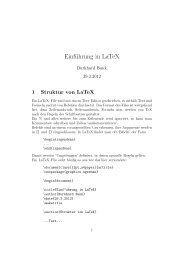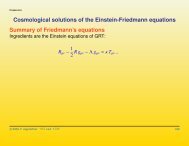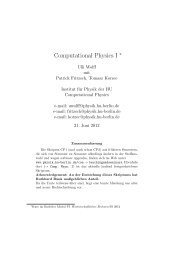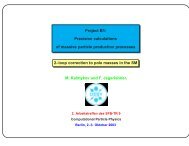Preprint[pdf] - HU Berlin
Preprint[pdf] - HU Berlin
Preprint[pdf] - HU Berlin
Create successful ePaper yourself
Turn your PDF publications into a flip-book with our unique Google optimized e-Paper software.
was subsequently cross–checked by Kataev [150]. A very recent calculation from the class of leading tenth<br />
order contributions (singlet (SI) VP insertion diagrams which includes the last diagram of Fig. 13 with two<br />
electron LbL loops) yields A (10)<br />
2 (mµ/me) = −1.26344(14) [151]. This result has been reproduced at the<br />
3% level by an asymptotic expansion in [152], where the much larger 4–loop non-singlet (NS) VP insertion<br />
with electron loops has also been calculated: A (10),as<br />
2 (mµ/me) = 63.481NS − 1.21429SI = 62.2667. Since the<br />
leading terms are included in Eq. (97) already and subleading terms are unknown in general, we will stay<br />
with the above result in the following.<br />
Thus, taking into account Eq. (53), we arrive at<br />
or<br />
C5 ∼ 663.0(20.0)(4.6)<br />
a<br />
(10) QED<br />
µ<br />
∼ 663(20)(4.6)<br />
�<br />
α<br />
�5 ≃ 4.483(135)(31) × 10<br />
π<br />
−11<br />
as an estimate of the 5–loop QED contribution.<br />
In Table 3 we collect the results of the QED calculations. In spite of the fact that the expansion coefficients<br />
Ci multiplying (α/π) i grow rapidly with the order, the convergence of the perturbative expansion of a QED<br />
µ<br />
is good. This suggests that the perturbative truncation error is well under control at the present level of<br />
accuracy.<br />
Table 3<br />
The QED contributions to aµ.<br />
. .<br />
Ci<br />
(2i) QED<br />
a µ × 1011 C1 0.5 a (2) 116140973.289(43)<br />
C2 0.765857 410 (27) a (4) 413217.620(14)<br />
C3 24.050509 64(46) a (6) 30141.902(1)<br />
C4 130.8105(85) a (8) 380.807(25)<br />
C5 663.0(20.0)(4.6) a (10) 4.483(135)(31)<br />
The universal QED terms have been given in Eq. (54) and together with the mass dependent QED terms<br />
of the 3 flavors (e, µ, τ) we obtain<br />
a QED<br />
µ = 116 584 718.104(.044)(.015)(.025)(.139)[.148] × 10 −11 . (99)<br />
The errors are given by the uncertainties in αinput, in the mass ratios, the numerical error on α 4 terms and<br />
the guessed uncertainty of the α 5 contribution, respectively.<br />
Now we have to address the question what happens beyond QED. What is measured in an experiment<br />
includes effects from the real world and we have to include the contributions from all known particles and<br />
interactions such that from a possible deviation between theory and experiment we may get a hint of the<br />
yet unknown physics.<br />
4. Hadronic Vacuum Polarization Corrections<br />
On a perturbative level we may obtain the hadronic vacuum polarization contribution by replacing internal<br />
lepton loops in the QED VP contributions by quark loops, adapting charge, color multiplicity and the masses<br />
accordingly. Since quarks are, however, confined inside hadrons, a quark mass cannot be defined in the same<br />
natural way as a lepton mass and quark mass values depend in various ways on the physical circumstances.<br />
Moreover, the running strong coupling “constant” αs(s) becomes large at low energies E = √ s. Therefore<br />
perturbative QCD (pQCD) fails to “converge” in any practical sense in this region and pQCD may only be<br />
38<br />
(98)


![Preprint[pdf] - HU Berlin](https://img.yumpu.com/3833433/38/500x640/preprintpdf-hu-berlin.jpg)




